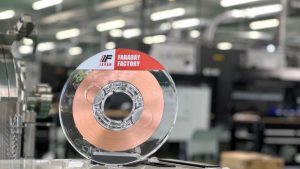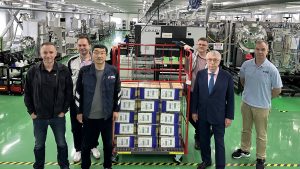Faraday Factory Japan is helping to accelerate the green transition with high-quality HTS tapes for zero-carbon technologies.
As the green transition gathers pace and research and development in the nuclear energy sector continues to ramp up, demand for reliable and efficient materials for use in nuclear and green technology is continually rising.
Innovating to meet this demand, Faraday Factory Japan is committed to the research, development and distribution of high-temperature superconducting (HTS) tapes for use in zero-carbon technologies. The Innovation Platform spoke to Sergey Lee, CEO of Faraday Factory Japan, to find out more about the company’s beginnings and how it has evolved today.
Can you elaborate on the background behind your company and your products?
Faraday Factory Japan was founded in 2011 as a startup focused on the manufacturing of second-generation high-temperature superconducting (2G HTS) wires. The key members of our Board of Directors are also shareholders, and most of us have known each other for decades. We began our academic journeys right around the time high-temperature superconductors were discovered and got extensive experience from renowned institutions worldwide. Our business activity was supported by lead investor Andrey Vavilov, who played a crucial role in the company’s establishment.
 General View of HTS tape
General View of HTS tape
Over the past 14 years, Faraday Factory Japan has achieved remarkable growth, evolving into a world leader in 2G HTS wire production. Operating around the clock, we have consistently met growing demands, with production volumes and product specifications surpassing those of competitors.
The decision to base the company in Japan was profoundly significant. It was made on 11 March 2011, mere hours before the devastating earthquake and tsunami that led to the Fukushima nuclear disaster. Reflecting on this timing, it seems more than coincidental; it feels like destiny guiding us toward contributing to clean energy solutions.
How are the superconducting tapes developed?
The 2G HTS tapes have been developed over the past three decades and are among the most complex objects in materials science and engineering. In general, these tapes are long (hundreds of metres), thin (a few tenth microns), and contain brittle ceramic films.
Structurally, 2G HTS tapes are built on a flexible metal substrate, typically made from nickel-based alloys such as Hastelloy, or, less commonly, stainless steel. Multiple oxide buffer layers, each ranging in thickness from a few to a few tens of nanometres, are deposited onto this substrate. These layers provide the necessary crystallographic texturing and lattice matching required for the subsequent epitaxial growth of the superconducting layer.
The superconducting layer, which is typically a few microns thick, consists of numerous highly anisotropic grains that must be perfectly aligned in all crystallographic directions to ensure efficient supercurrent flow of several million Amperes per cm². Even minor impurities at grain boundaries can significantly impede performance. Interestingly, while perfect grain boundary connections are essential for supercurrent transmission, a high density of nanoscale defects is also necessary to maintain performance in strong magnetic fields. These defects act as pinning centres, anchoring superconducting vortices to preserve current flow under high-field conditions.
What makes your company and products different?
A variety of thin-film deposition techniques – both chemical and physical – are employed to fabricate these multilayers, usually in a continuous roll-to-roll production mode. The long-term stability and precision of these processes are absolutely crucial, as any defects introduced at one stage will propagate through subsequent layers and inevitably appear in the final product testing. In this highly integrated system, there is no way to ‘fix’ a problem once it occurs – every step must be perfect.
 Faraday Factory Board members in front of the shipment, which completes the largest delivery contract in the history of HTS
Faraday Factory Board members in front of the shipment, which completes the largest delivery contract in the history of HTS
At Faraday Factory Japan, we have developed and implemented high-speed ion beam assisted deposition (IBAD) as a key process for fabricating textured magnesium oxide (MgO-based) buffer layers, and pulsed laser deposition (PLD) for the high-rate deposition of superconducting layers. Our production equipment is uniquely designed and custom-built in collaboration with specialised equipment manufacturers. The creativity and 35 years of experience of our team, combined with continuous feedback from our production line and R&D department to the equipment makers, have allowed us to create new generations of production equipment.
Operating 24/7, we have achieved mass production of thousands of kilometres of superconducting tapes, providing us with unique experience and enabling us to establish reliable working regulations and protocols for high-yield production of these complex materials. There is no other company in the world that has accumulated such production statistics and hands-on experience in manufacturing thousands of batches of superconducting tapes.
Can you highlight some of your key achievements?
Faraday Factory Japan has achieved several significant milestones:
World’s largest 2G HTS wire production: We have established the world’s largest production facility for second-generation high-temperature superconducting (2G HTS) wires, operating 24/7.
Product customisation: We provide a highly customised product for various applications in a wide temperature (77-4K) and magnetic field ranges (up to 40T).
Consistent profitability: Over the past seven years, we have been the only company in this field to generate annual net profits, regardless of production volume growth from tens to thousands of kilometres.
Multinational team: Our diverse team, representing over 20 nationalities, has been instrumental in these accomplishments. We foster an inclusive culture that encourages continuous learning and innovation.
Participation in national R&D programmes: We are actively involved in national research and development programmes supported by organisations such as NEDO (METI) and JST (MEXT), alongside our commercial activities.
How are you aiding in the journey to fusion commercialisation?
Superconducting magnets are essential for magnetic confinement of high-temperature plasma in fusion reactors. The advancement of new compact fusion reactors relies heavily on magnets constructed with second-generation high-temperature superconductors (2G HTS), capable of generating magnetic fields exceeding 20 Tesla, particularly at temperatures far above liquid helium’s boiling point (e.a, 20K).
Faraday Factory Japan is recognised as a global leader in producing and supplying 2G HTS wires for compact fusion applications. As of April 2025, the company achieved a significant milestone by delivering over 7,000km of high-temperature superconductor tape to various fusion projects worldwide. These deliveries have supported a range of fusion reactor designs, including tokamaks, stellarators, levitating dipoles, and magnetic mirrors.
The quality and reliability of Faraday Factory’s HTS wires have been validated through their successful integration into several fusion reactor prototypes. Notably, superconductors produced by Faraday Factory have been instrumental in achieving first plasma in a levitated dipole fusion prototype, demonstrating their critical role in advancing fusion energy technology.
What’s next for your company?
Looking ahead, we are committed to scaling up production to meet the increasing demand for 2G HTS wires. In April 2024, Faraday Factory expanded its production capabilities by opening a new three-storey factory in Zama City, Kanagawa Prefecture. This facility enhances the company’s capacity to meet the growing demand for high-performance superconducting materials essential for sustainable and efficient fusion power generation.
We anticipate that demand from fusion companies will dominate the 2G HTS market in the next decade, serving as a significant growth driver. Beyond fusion, we are actively promoting our products in other sectors. Notably, the cable industry is showing increased interest, as superconducting wires offer a solution to the anticipated copper shortages in electrical cable manufacturing. High-speed transportation also presents a promising market. Superconducting MagLev trains and electric aeroplanes are transitioning from conceptual designs to practical applications, with 2G HTS technology expected to play a pivotal role in their commercial implementation within the next decade.
Our goal is to make 2G HTS affordable and available, enabling transformative projects across various industries. High-temperature superconducting wires exemplify a transformative technology, with no viable alternatives for the future development of human society.
Please note, this article will also appear in the 22nd edition of our quarterly publication.


AloJapan.com